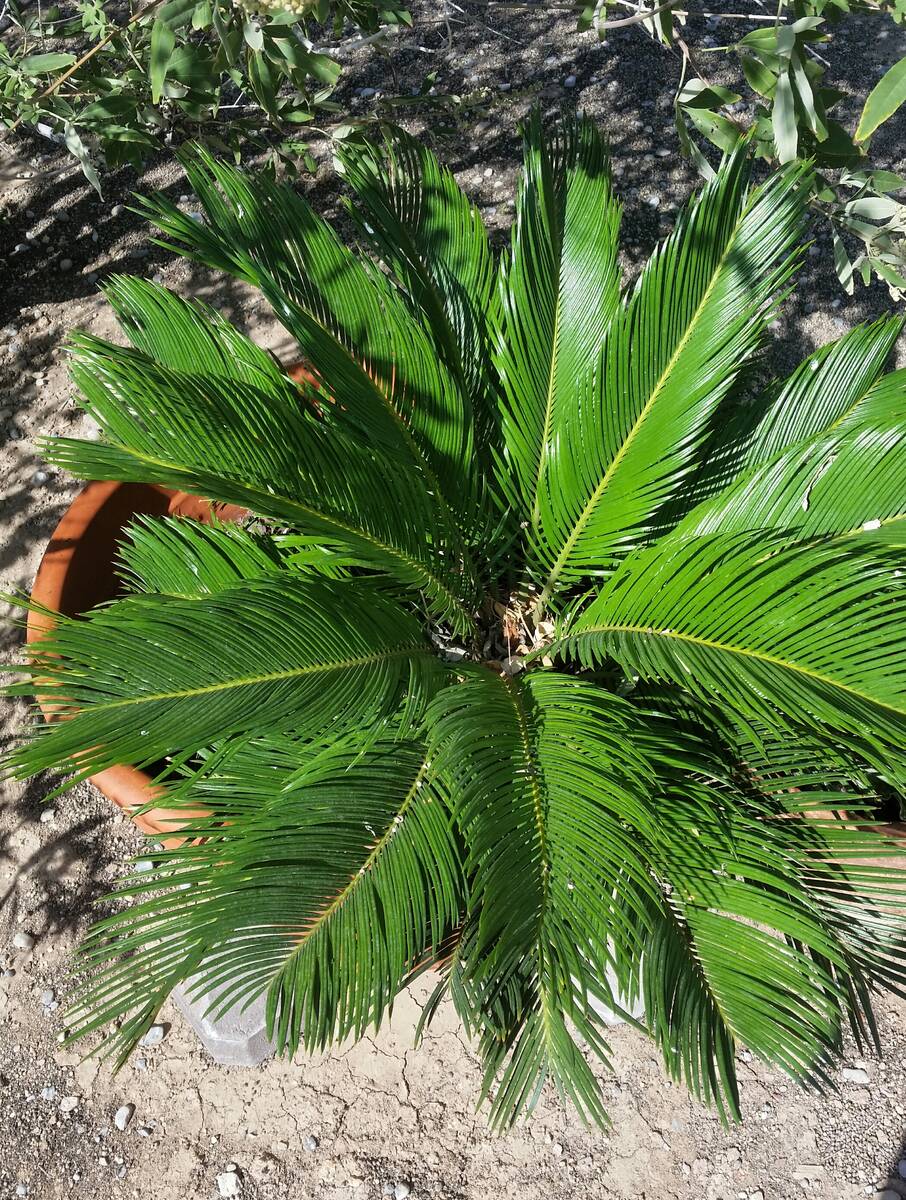Weekly deep watering should be OK for sago palm
Q: Now that our irrigation is only allowed for one day, I was wondering if once a week is sufficient watering for my small sago palm. Should I hand water it on other days?
A: Hard to say. Depends on how much water the soil around the sago palm holds, where the drip emitters for it are located and the side of the house it’s on.
Ideally, the drip emitters are located between 12 to 18 inches from the trunk. For large sago palms, I would suggest three emitters spaced in a triangle. Run the irrigation system long enough to water 12 to 18 inches deep. You can measure that with something long, skinny and hard like a piece of rebar.
If the sago palm is smaller, it may need only two emitters to wet the soil to the same depth. Smaller plants don’t use as much water, but the system needs to run just as long.
Plants on the south and west sides of the home use water faster than those on the east and north sides. A deep watering once a week should be all that is necessary for them in most soils and locations except the hottest.
Q: I have pines and eucalyptus that are not being irrigated at all. There is no irrigation applied but these trees are tall and healthy. What gives?
A: Trees need water to survive. And large trees need more water than smaller ones. Some trees such as your eucalyptus and many pines can grow deep roots. But trees need a minimum amount of water, so they are getting water from somewhere.
Plants are lazy, like us. Tree roots take up water where it’s easiest to survive. If they want to reproduce, then they need more than enough to survive. If the deep water is easy to follow, then the three will use it if their roots can reach it.
Tree roots don’t seek water in dry soil. They chase it. They sense water is there (compared to the dry soil surrounding their roots) and grow best where water and air are abundant.
If the tree can get lots of shallow water, like growing in a lawn, then that’s where tree roots grow abundantly as long as they can get air as well. If the water is deep, then that’s where roots grow if the soil is moist often enough to attract tree roots and they can breathe.
Established pine trees grew without water at the El Rancho on the Las Vegas Strip after its fire. The property was abandoned, and the irrigation was turned off as well.
Pine trees had to survive on only the deep salty water that their roots could get several feet below the Strip. This available water used to be considered a nuisance until developers saw its value in the desert. As Mark Twain used to say, “Whiskey is for drinking; water is for fighting over.”
Both established pine and eucalyptus trees have the potential to develop deep roots if given a chance and find a deep source of water.
Q: My potted Meyer lemon tree has wrinkles on the leaves. The nursery told me that the leaves have an insect living inside the leaves. I used whatever product was sold to me last spring and the leaves still look wrinkled. This is my second year having the tree, and it has 12 lemons on it.
A: The nursery was right. The leaves of your Meyer lemon have leaf miners inside of them. But the product you were using was wrong.
Leaf miners are usually small flies that lay eggs on the surface of the leaves. These eggs hatch and the maggot of this fly tunnels between the outer surfaces of the leaves. Previous to yours, the only place I ever saw leaf miners on Meyer lemons was in another country grown inside a plastic tunnel they called a greenhouse.
There is no insecticide I would use to control them. The usual method is to hand remove or pick the infested leaves and immediately destroy them.
Leaf miners found inside tree leaves are usually a minor problem when growing citrus. Their life cycle can be easily interrupted by removing infested leaves. Leaf miners are more of a problem in leafy greens such as spinach and lettuce.
A word of caution. These leaves must be destroyed soon after they are removed, or the leaf miner insect will continue to infest other leaves.
I guess if you were to use an insecticide for controlling leaf miners, then I would spray a systemic insecticide such as imidacloprid if it is labeled for food crops. But in your case, the easier and safer method is to remove infested leaves and immediately destroy them and interrupt the insect’s lifecycle.
Q: We have a century plant thriving over the past 10-12 years in our front yard. Toward the end of summer, we noticed lower leaves were getting soft and tender, leathery even, eventually turning yellow. No new shoots are visible emerging from the core. It gets watered occasionally.
A: Century plant is an agave weevil magnet. My guess is that’s the problem. The only method I know to control agave weevils is to apply an insecticide around the base of all agaves in March or April of every spring. The insecticide is used to protect the plant from spring infestations. Sprinkle a granular insecticide at the base of the plant and lightly water it.
The adult weevils have wings and can fly. They can fly from a neighbor’s plants to a different neighbor’s landscape. These adult beetles lay their eggs in the crotches of the agave in the spring.
They don’t use calendars but fly during the spring when it’s perfect weather. That is why the timing for an application is “sometime in the spring.”
The grubs hatch from the eggs and tunnel inside the core of many different types of agaves and cause their tunneling damage. Sometimes the damage is so severe it kills the plants outright or it might cause a smaller problem when plants are larger.
The other usual problem is watering too often. This can weaken or kill the plant. It doesn’t sound like that is your problem.
I would caution you to water the plants deeply and not just sprinkle them with a hose. Depending on the size of the agave it can take from 5 to 15 gallons of water varying from a small to a large American agave.
If the American agave is large, then use three drip emitters located about 12 to 18 inches from the plant in a triangular spacing and watch for signs of stress. Apply water about three to six weeks apart during the summer.
Q: I have a 20-plus-year-old eucalyptus tree. The leaves are very yellow. What is the cause of this?
A: Yellowing leaves can mean many things. It could be a nutritional problem, watering issues or damage from insects or disease. I need more information as well as leaf and tree pictures. Make sure it gets an iron application to the soil in the spring. To be on the safe side, apply an iron chelate such as EDDHA.
Check for a watering issue or a leak that floods the soil in that area. Eucalyptus is mesic in its water use so an application frequency for large trees should be used. When water is applied it should be deep and wide or large shrubs that receive water should be located under its canopy. Once a tree is chosen, its increasing water use as it gets bigger has also been chosen.
Q: I found a plant growing under my fig tree. It has sticky leaves, tiny white flowers and clusters of small green balls. Any idea what it might be?
A: Toxic black nightshade is a common weed that grows when the temperatures begin to cool off. It has white flowers that are ⅜ inch in diameter and resemble tomato flowers. They produce immature green fruit that is ball-shaped that varies from ⅜ to ½ inch in diameter. These green balls of fruit turn darker and sometimes black when they mature.
If the plant attracts aphids, then it can get sticky due to aphid excrement from sucking the internal juices of the plant. Even though the plant is poisonous, aphids do like this plant.
Like any weed growing near fruit trees, pull it when the soil is moist and get rid of it. Otherwise, the aphids will ride the winter out at about soil level as it gets colder and spread to your fruit trees in the spring.
Bob Morris is a horticulture expert and professor emeritus of the University of Nevada, Las Vegas. Visit his blog at xtremehorticulture.blogspot.com. Send questions to Extremehort@aol.com.





























